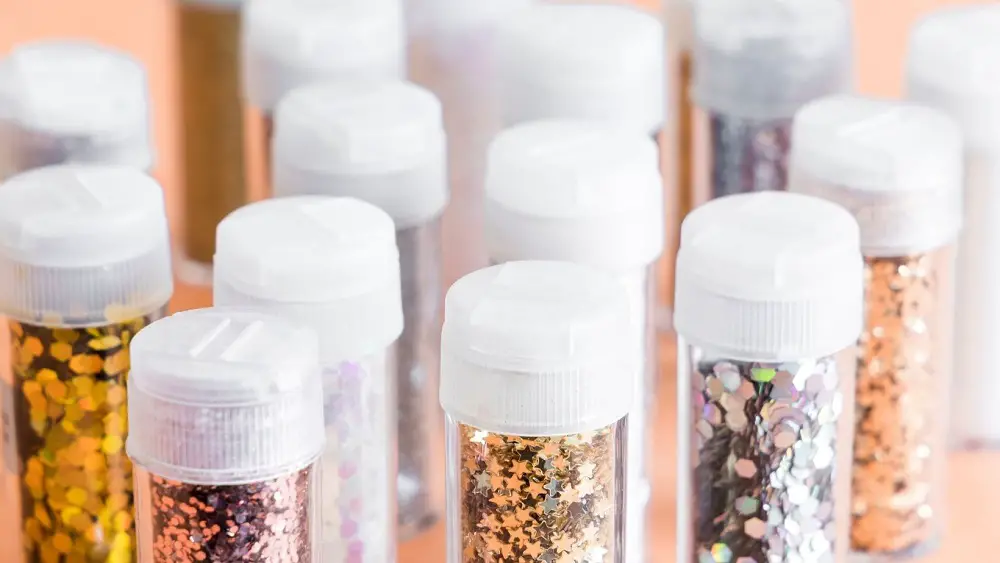Glitter is a fun and shiny material. It’s a wonderful way to bring sparkle to your skin, hair, or art, and it’s available in a variety of cosmetics nowadays.
Of course, not everyone understands how glitter is created in the first place. What exactly is it composed of?
How does it come to be? What happens if you flush it down the toilet or rinse it off your face or body?
In this article, we’ll guide you through the glitter making process and the positives and negatives that come along with it.
Different types of glitter can have different effects on the planet and the environment. Let’s dive in!
So, How Is Glitter Made?
To begin, realise that the majority of the glitter in cosmetics is composed of plastic. Other varieties of glitter, such as glass, are available, but they are rarely used on the skin.
They’re primarily used for crafts. So, glitter is made of plastic.
Glitter begins its journey as a large plastic sheet. It’s made from heated plastic pellets and afterwards wrapped in a coating of foil to offer it that lustrous sheen you like.
The sheet must then be sliced into very tiny bits after it has been produced. This is often done electronically or mechanically, and there are many sizes and shapes to choose from.
Hexagonal shaped glitter is the most prevalent, but square is also pretty popular. There are several others too though.
There are numerous machinery designs, blade patterns, and other factors to consider, but it ultimately boils down to putting the strip of plastic into the device, where blades slice (or die punch) it into the required shape.
The small glitter particles are then taken from the device (or fed out in an electronic machine) and bundled into the finished product, which could be a glitter bottle, a spray mixture, cosmetics, or something else entirely.
Why Is Glitter A Problem?
The majority of people don’t associate glitter with microfibers. One is glitzy, gleaming, and a lot of pleasure to use. The other is a problem for the environment that you try to steer clear of.
Here’s the problem: they’re essentially the same thing. Microbeads are very small plastic pearls. Glitter is as well. When they’re thrown away, they can cause the same problems.
Let’s imagine you’ve just spent a night out and it’s time to start taking off your glittering makeup. You tidy up, take a hot shower, and retire to your bed.
Meanwhile, the glitter you just swept away is carried down the drain, through the sewage pipes, and into the water treatment facility. Those microscopic particles are too minuscule to be caught when they arrive, so they are pushed out into the sea.
Your glitter essentially becomes part of the plastic stew in the oceans, polluting the waterways and destroying marine life.
Despite the obvious danger that glitter poses to the planet, the health hazards associated with these small plastic nanoparticles have yet to be thoroughly investigated.
Glitter is made up of a variety of chemical products as well as potentially hazardous elements. As a result, we can’t rule out the likelihood that the particles are hazardous to human health.
Not only when you get a particle in your eyes, swallow or breathe them in, but also when you come into constant touch with the body. There are a variety of reasons to give up glitter.
What About Biodegradable Glitter?
We’re not the only one to criticise the way traditional plastic glitter is created and the materials it’s manufactured from. Alternatives such as compostable glitter, sometimes known as “green glitter,” are now commercially available.
Some companies promise to use cellulose acetate, which is the same substance used in cigarettes. Other glitters, it appears, use a variety of biodegradable polymers.
After doing some research, we discovered that several biodegradable glitter companies do not state clearly which ingredients are used in the manufacturing of their “eco glitter.”
Biodegradable glitter is unquestionably the superior choice if you’re going to purchase it. Nonetheless, there are solid reasons to avoid it entirely:
To begin with, bioplastics are not without controversy. Second, does a wasteful product like glitter truly warrant the resource-intensive manufacturing process and environment issues?
In fact, we can extend this question to several aspects of our daily life and the items we use. It’s also a question that we can only solve for ourselves.
What About Edible Glitter?
According to the FDA, edible glitter is made up of components like sugar, starch, acacia, maltodextrin, and food-safe colour compounds.
It’s not enough for edible glitter to be labelled non-toxic; it also needs to have a complete list of ingredients so that you can double-check that it doesn’t include any plastics or poisonous compounds that could be detrimental to consume.
What About Mica Powder?

Mica is a color pigment which is sometimes glittery and is often used in cosmetic products and the arts and crafts industry.
Mica powder pigment is very small and doesn’t have the same environmental risks as regular plastic glitter, but this doesn’t mean that it’s any better for the planet as a whole. It’s a slight improvement, but it’s definitely not a solution.
This is because Mica mining is labor-intensive by its inherent nature. In impoverished nations, it is also typically carried out by more vulnerable individuals.
Muscovite mica is a major export from India. Mica mining is primarily done manually, and it entails trekking long distances down tiny mining shafts.
Many sheet mica workers are, sadly, underpaid, unregulated, and so exploited. They can live and work in rural places with little right to schooling and medicine.
There are also fears that mica mining in non-western nations could have a detrimental effect on children’s rights.
Illegal mica mining exists in various nations, providing additional dangers to those participating and, because it is uncontrolled, also to the planet.
Mineral preservation should also be considered when mining mica. This should imply a greater focus on collection and processing effectiveness, as well as minimising over-exploitation of mineral wealth.






